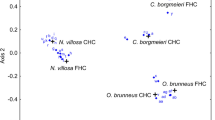Summary
An experiment was performed to assess the relative survival of two forms of 5th instar larvae of Lygaeus equestris (Heteroptera, Lygaeidae) — the normal red form, called aposematic, and a mutant grey form, called cryptic — when given to hand-raised great tits (Parus major).
Sixteen birds were presented with aposematic larvae and 16 were presented with cryptic larvae in 10 consecutive trials. One attack per trial was allowed. Both larval forms were presented against a background matching the grey larvae, but since both prey types were presented in a specific place known to the predator, detection rate for both was assumed to be unity.
Birds learned to avoid both prey types. However, the survival of the aposematic larvae was higher than that of the cryptic ones due to three aspects of predator behaviour: i) a greater initial reluctance to attack, ii) a more rapid avoidance learning, and iii) a lower frequency of killing in an attack, when the prey was aposematic. Moreover, a greater number of birds learned to avoid prey without killing any individual, when the prey was aposematic. This result is considered to be due to prey coloration alone, since, in a separate test, no difference in prey distastefulness could be detected.
This experiment shows that individual prey can benefit from being aposematic and indicates that individual selection can be a sufficient explanation for the evolution of aposematic coloration. It was concluded that, since the survivorship was 6.4 times higher for the aposematic prey, it could have a detection rate that is correspondingly higher than the cryptic in order for the two forms to have equal fitness.
Similar content being viewed by others
References
Benson WW (1971) Evidence for the evolution of unpalatability through kin selection in the Heliconiinae (Lepidoptera). Amer Nat 105 (913):213–226
Brower LP (1984) Chemical defence in butterflies. In: The Biology of Butterflies, RJ Vane-Wright, PR Ackery (eds). Academic Press, London
Coppinger RP (1969) The effect of experience and novelty on avian feeding behavior with reference to the evolution of warning coloration in butterflies. I. Reactions of Wild-Caught adult Blue Jays to novel insects. Behaviour XXXV:45–60
Coppinger RP (1970) The effect of experience and novelty on avian feeding behavior with reference to the evolution of warning coloration in butterflies. II. Reactions of naive birds to novel insects. Amer Nat 104:323–335
Cott HB (1940) Adaptive coloration in animals. Methuen, London
Curio E (1976) The ethology of predation. Springer, Berlin Heidelberg New York Tokyo
Fisher RA (1958) The genetical theory of natural selection, 2nd ed. Dover, New York
Gittleman JL, Harvey PH (1980) Why are distasteful prey not cryptic. Nature 286:149–150
Goodale MA, Sneddon J (1977) The effect of distastefulness of the model on the predation of artificial Batesian mimics. Anim Behav 25:660–665
Harvey PH, Greenwood PJ (1978) Anti-predator defence strategies: some evolutionary problems. In: Behavioural ecology, an evolutionary approach, JR Krebs, NB Davies (eds) Blackwell, Oxford, pp 129–151
Järvi T, Sillén-Tullberg B, Wiklund C (1981) The cost of being aposematic. An experimental study of predation on larvae of Papillo machaon by the great tit Parus major. Oikos 36:267–272
Papageorgis C (1975) Mimicry in neotropical butterflies. Am Sci 63:522–532
Remold H (1963) Scent-glands of land-bugs, their physiology and biological function. Nature 198:764–768
Scudder GGE, Duffey SS (1972) Cardiac glycosides in the Lygaeinae (Hem.: Lygaeidae). Can J Zool 50:35–42
Sillén-Tullberg B, Bryant EH (1983) The evolution of aposematic coloration in distasteful prey: an individual selection model. Evolution 37:993–1000
Staddon BW (1979) The scent glands of Heteroptera. In: Advances in insect physiology, JE Treherne, MJ Berridge, VB Wigglesworth (eds) Academic Press, London New York
Turner JRG (1971) Studies of Müllerian mimicry and its evolution in burnet moths and heliconid butterflies. In: Ecological genetics and evolution, R Creed (ed). Blackwell, Oxford, pp 224–260
Windecker W (1939) Euchelia (Hypocrita) Jacobaea L. und das Schutztrachtenproblem. Z Morph Oekol Tiere 35:84–138
Wiklund C, Järvi T (1982) Survival of distasteful insects after being attacked by naive birds: a reappraisal of the theory of aposematic coloration evolving through individual selection. Evolution 36:998–1002
Wiklund C, Sillén-Tullberg B (1985) Why distasteful butterflies have aposematic larvae and adults but cryptic pupae: evidence from predation experiments on the monarch and the European swallowtail. Evolution (in press)
Author information
Authors and Affiliations
Rights and permissions
About this article
Cite this article
Sillén-Tullberg, B. Higher survival of an aposematic than of a cryptic form of a distasteful bug. Oecologia 67, 411–415 (1985). https://doi.org/10.1007/BF00384948
Received:
Issue Date:
DOI: https://doi.org/10.1007/BF00384948




